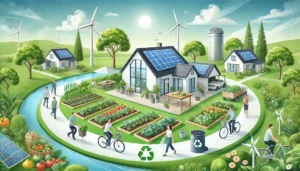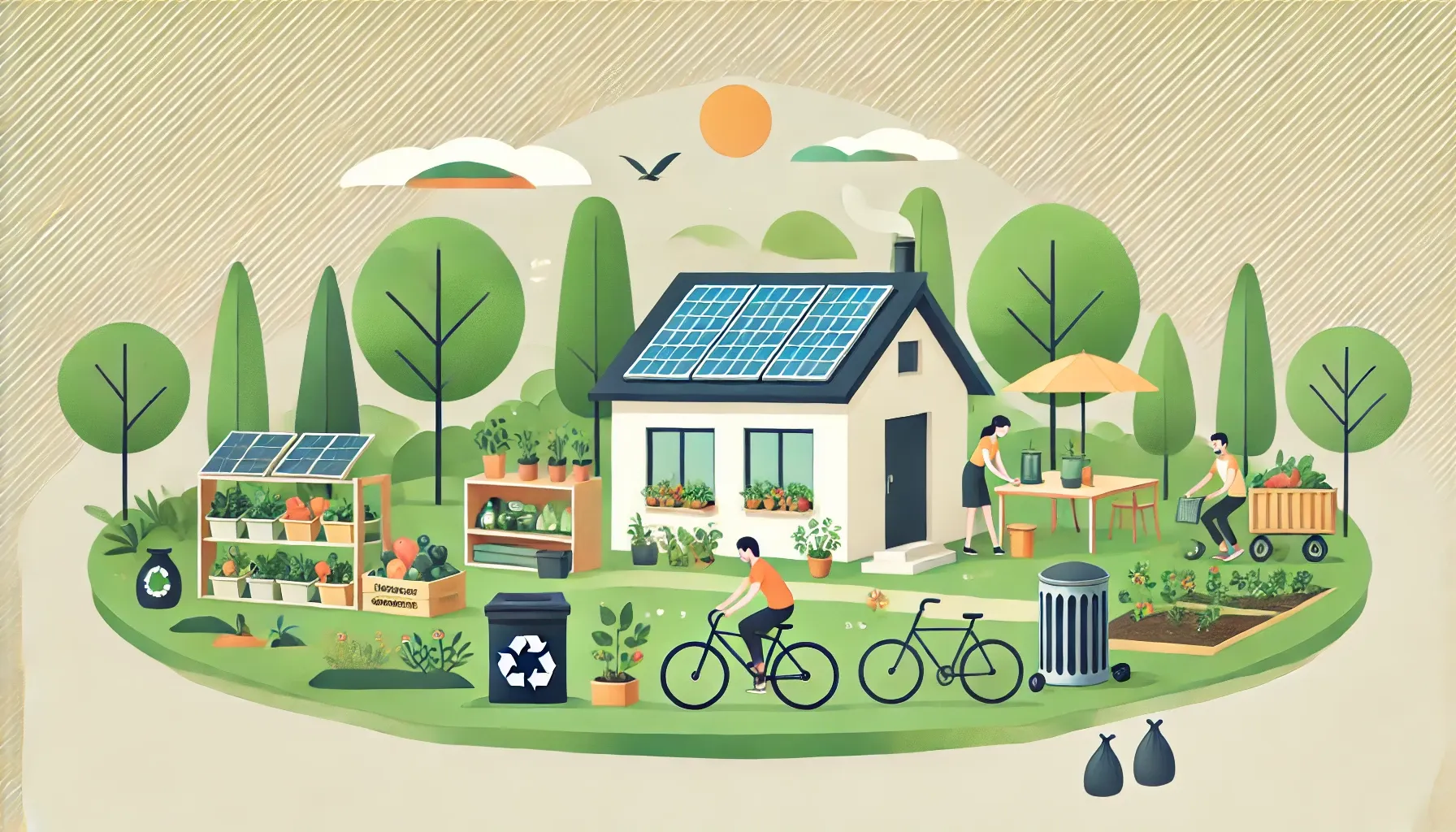Introduction
Well, at the time of writing this article I can confirm that living an eco-responsible life is not just a trend – it absolutely needs to be a commitment. Sustainable options in our everyday lives not only lower the carbon footprint but also bring a balance with nature. In this all-encompassing guide, we show you how to consider the environment in your regular day-to-day existence and provide tips on getting started with practical sustainable living.
Understanding Sustainability
It means using what we need without taking more and staying within the capacities of our environment to continue to support all human life as well as other species. These pillars are: Environmental Sustainability, Social Justice and Economic Development. Simply put, it stands for living within the resources of nature (IE) both in receipt thereof and its disposal thus at once to allow other species to survive while providing society with what they need from these systems.

Why Sustainability Matters
The beauty of sustainability is in the balance it aims to restore. Over-extraction of natural resources, unregulated pollution, and lack of social justice give rise to a range of ecosystem services such as climate change, biodiversity loss, or even social exclusion. Sustainable living is created for these issues to evade them and making sure that we are consuming responsibly and thinking of our production methods.
Daily Life Choices for a Sustainable Lifestyle
Home and Energy
- Energy Efficiency
- Invest in Energy-efficient Appliances: Look for appliances that are labeled as having Energy Star ratings. They consume a lower amount of energy and water than the traditional models.
- Smart Thermostats: These beauties can learn your schedule and turn up and down in the daytime, saving a huge chunk of energy.
- Lighting: LEDs LED bulbs use less energy and last longer than incandescent lightbulbs.
- Renewable Energy
- Solar Panels: Solar panels installation helps reduce dependence on fossil fuels and eventually lower the electricity bills.
- Wind Turbines (but only if you have the space): If you have enough space on your property, small-scale wind turbines can be a good option for generating renewable energy.
- Green Energy Plans: Many utility companies now offer green energy plans which source electricity from renewable sources.
- Insulation and Windows
- Insulation: Reduce the heating and cooling requirements of your home, therefore wasting less energy.
- Energy-efficient Windows: Pay particular attention when looking for double-glazed or triple-glazed windows rather than single-glazed windows that retain more heat.
Water Conservation
- Efficient Fixtures
- Low-flow Toilets and Showerheads: Residential toilets use 20 to 26.5 gallons of water per day on average, where standard municipal daily generation rates are approximately 82 GPCD (gallons per capita day).
- Faucet Aerators: Installing aerators in faucets can decrease water flow rates without changing the pressure of the stream.
- Water-wise Landscaping
- Xeriscaping: It is a landscaping approach which reduces water usage by placing and supporting drought-resistant plants.
- Rain Barrels: Rainwater Collection for watering plants & saving tap water.
Waste Reduction
- Reduce, Reuse, Recycle
- Waste less: Say no to single-use products, and choose items with little packaging.
- Repurpose: Reuse items if possible. For instance, store these in glass jars.
- Recycle: All recyclables should be separated from normal waste before recycling. Get to know your local recycling laws.
- Composting
- Composting at Home: Compost organic waste such as food scraps and yard cuttings also helps to prevent landfill overload in addition to producing quality soil for gardening.
- Join community composting programs if onsite is not possible.
Transportation
- Independent Alternative Transportation
- Public Transport: Encourages buses, trains, and trams to reduce the number of cars on the road.
- Cycling and Walking: Walk or bike for short trips – it is better for your health, the planet.
- Carpool: Ride sharing is when you pool your car with another to a particular destination and reduce the number of cars on the road as well as emission.
- Eco-friendly Vehicles
- Zero-Emissions Vehicles: Any type of electric vehicle makes no carbon footprint and is becoming cheaper.
- Hybrid Cars: These cars feature the combination of a traditional motor and electrical engine used to enhance fuel mileage.
- Fuel Efficient Cars: Prefer cars with high mileage in order to consume fewer fuels.
Sustainable Food Choices
- Plant-based Diet
- Consume Less Meat: It is well known that meat production is one of the most polluting factors for our environment. However, adding to your diet more foods that are plant-based can lead to a 70% decrease in carbon footprint.
- Local and Seasonal Foods: One way to reduce transportation miles (fossil fuel-based) is consequent to your food. Fresher, and it takes a lot fewer resources to grow them since they are in season.
- Organic and Fair Trade
- Natural and Organic Foods: Natural foods are more environmental as they avoid the use of synthetic fertilizers and pesticides.
- Buying Fair Trade Products: This ensures that the farmers and workers are paid properly and they work in good conditions.
Clothing and Fashion
- Sustainable Fashion
- Eco-Friendly Fabrics: When you can, go with organic cotton or bamboo as well as recycled fabric choices.
- Used and Vintage: Purchasing items second-hand not only lessens the need for new goods – thus reducing impact – but it gives them a longer life.
- Quality over Quantity: Invest in pieces that last longer meaning your purchase will also help reduce waste.
- Ethical Brands
- Research Brands: There are brands now that actually have very open manufacturing processes and labor practices.
- Swap Clothing: Involve in clothes swaps to update your collection without buying new.
Household, Personal Care, and Cleaning
- The Best Natural Non-toxic Products
- Cleanse the Environment with Nature: Utilize compostable and vegan household dry cleaning supplies.
- Personal Care Products: Avoid creating waste by using great natural products without packaging.
- DIY Solutions
- Cleaning Ingredients: Some of the easiest ingredients for cleaning are actually things like white vinegar, baking soda, and lemon which will start you off on a series about making basic homemade cleaners.
- Personal Care DIY: Create your own personal care products, like toothpaste and deodorant with healthful ingredients.
Community and Advocacy
Community Involvement
- Support Local Initiatives
- Farmers’ Markets: Shopping locally at farmers markets contributes to the local economy and cuts down on food miles from transportation.
- Community Gardens: If you have an interest in food security and the environment, this is a great way to encourage local food production as well as create beautiful community green spaces.
- Volunteering
- NGO and Charitable Organizations: Join the bandwagon of conservationists in their fight to protect natural habitat through volunteering efforts.
- Waste Collecting Drives: Attend any of the local waste collection events running in your locality to help keep clean.
Advocacy and Education
- Raise Awareness
- Social Media Platform: Share information and spread awareness about sustainable living practices.
- Events and Workshops: Host or participate in sustainability events to teach others while connecting with fellow sustainable living enthusiasts.
- Policy Change
- Support Green Policies: Encourage policies that support renewable energy, not pollution on or just above Alaska’s Public Lands.
- Vote with Your Dollar: Choose to support companies and products that are doing good for the planet.
The Problems and Their Solutions of Sustainable Living
Common Challenges
- Cost
- Potential Expense: It appears that sustainable goods and operations may have a higher cost to invest.
- Solution: Think big – keep the long-term savings and benefits. For instance, energy-efficient appliances and renewable sources of power often save money in the long run by charging you less on utility bills.
- Convenience
- Not Always Convenient: Using sustainable options to go about life takes more preparation than just throwing plastic in the garbage.
- Solution: Work to implement a more sustainable routine step by step. Begin making small changes, build to this.
- Information Overload
- Confusing Information: There is so much information out there on sustainability that it leads to confusion.
- Solution: Dig your heels into reliable places and make sure first things are truly made to count. You can use environmental organizations and government websites to find reliable information.
Measuring Your Impact
Tracking Progress
- Carbon Footprint Calculators
- Online Calculators: Utilize online calculators that will give you a rough idea of what your carbon footprint looks like and highlight areas where you can improve.
- Check In: Re-evaluate your carbon footprint periodically to monitor change and adapt as needed.
- Eco-friendly Apps
- Sustainable Living Apps: Download apps that can help you track and improve your sustainable practices.
- Community Platforms: Check out online community sites dedicated to sustainability for help and inspiration.
Conclusion
Living sustainably is not about the destination but a journey. This means constant learning, change, and doing what feels better for the Earth, ancestors, and future generations. When each of us adds sustainable practices to our daily lives, it makes a difference. Everything from energy saving and water conservation to waste reduction and sustainable food choices can make a difference if you do your small part. The sustainable path is a fair way to live, making responsible choices and efforts in order to create a healthier environment for others too.
